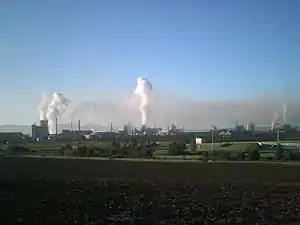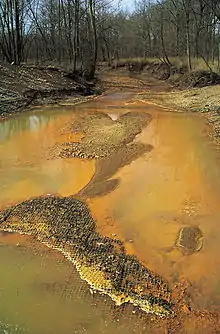

Heavy industry is an industry that involves one or more characteristics such as large and heavy products; large and heavy equipment and facilities (such as heavy equipment, large machine tools, huge buildings and large-scale infrastructure); or complex or numerous processes. Because of those factors, heavy industry involves higher capital intensity than light industry does, and is also often more heavily cyclical in investment and employment.
Though important to economic development and industrialization of economies, heavy industry can also have significant negative side effects: both local communities and workers frequently encounter health risks, heavy industries tend to produce byproducts that both pollute the air and water, and the industrial supply chain is often involved in other environmental justice issues from mining and transportation. Because of their intensity, heavy industries are also significant contributors to greenhouse gas emissions that cause climate change, and certain parts of the industries, especially high-heat processes used in metal working and cement production, are hard to decarbonize.[1] Industrial activities such as mining also results in pollution consisting of heavy metals. Heavy metals are very damaging to the environment because they cannot be chemically degraded.[2]
Types
Transportation and construction along with their upstream manufacturing supply businesses have been the bulk of heavy industry throughout the industrial age, along with some capital-intensive manufacturing. Traditional examples from the mid-19th century through the early 20th included steelmaking, artillery production, locomotive manufacturing, machine tool building, and the heavier types of mining. From the late 19th century through the mid-20th, as the chemical industry and electrical industry developed, they involved components of both heavy industry and light industry, which was soon also true for the automotive industry and the aircraft industry. Modern shipbuilding (since steel replaced wood) and large components such as ship turbochargers are also characteristic of heavy industry.[3]
A typical heavy industry activity is the production of large systems, such as the construction of skyscrapers and large dams during the post–World War II era, and the manufacture/deployment of large rockets and giant wind turbines through the 21st century.[4]
As part of economic strategy
Many East Asian countries relied on heavy industry as key parts of their development strategies[5] and many still do for economic growth.[6] This reliance on heavy industry is typically a matter of government economic policy. Among Japanese and Korean firms with "heavy industry" in their names, many are also manufacturers of aerospace products and defense contractors to their respective countries' governments such as Japan's Mitsubishi Heavy Industries and Fuji Heavy Industries, and Korea's Hyundai Rotem, a joint project of Hyundai Heavy Industries and Daewoo Heavy Industries.[7]
In 20th-century communist states, the planning of the economy often focused on heavy industry as an area for large investments (at the expense of investing in the greater production of in-demand consumer goods), even to the extent of painful opportunity costs on the production–possibility frontier (classically, "lots of guns and not enough butter").[8] This was motivated by fears of failing to maintain military parity with foreign capitalist powers. For example, the Soviet Union's industrialization in the 1930s, with heavy industry as the favored emphasis, sought to bring its ability to produce trucks, tanks, artillery, aircraft, and warships up to a level that would make the country a great power. China under Mao Zedong pursued a similar strategy, eventually culminating in the Great Leap Forward of 1958–1960; an unsuccessful attempt to rapidly industrialize and collectivize, that led to the largest famine in human history, killing up to 50 million people, whilst simultaneously severely depleting the production of agricultural products and not increasing the output of usable-quality industrial goods.[9][10]
In zoning
Heavy industry is also sometimes a special designation in local zoning laws, allowing placement of industries with heavy impacts (on environment, infrastructure, and employment) with planning. For example, the zoning restrictions for landfills usually take into account the heavy truck traffic that will exert expensive wear on the roads leading to the landfill.[11]
Environmental impacts
Greenhouse gas emissions
As of 2019, heavy industry emits about 22% of global greenhouse gas emissions: high temperature heat for heavy industry being about 10% of global emissions.[12] The steel industry alone was responsible for 7 to 9% of the global carbon dioxide emissions which is inherently related to the main production process via reduction of iron with coal.[13] In order to reduce these carbon dioxide emissions, carbon capture and utilization and carbon capture and storage technology is looked at. Heavy industry has the advantage of being a point source which is less energy-intensive to apply the latter technologies and results in a cheaper carbon capture compared to direct air capture.
Pollution
Industrial activities such as the improper disposal of radioactive material, burning coal and fossil fuels, and releasing liquid waste into the environment contribute to the pollution of water, soil, air, and wildlife.[14]
In regards to water pollution, when waste is disposed of in the environment, it affects the quality of the available water supply which has a negative impact on the ecosystem along with water supply used by farms for irrigation which in turn affects crops.[14] Heavy metals have also been shown to pollute soil, deteriorating arable land quality and adversely impacting food safety (such as vegetables or grain).[15] This occurs as a result of heavy industry when those heavy metals sink into the ground contaminating the crops that reside among it.[16]
Heavy metal concentrations resulting from water and/or soil pollution can become deadly once they pass certain thresholds, which lead to plant poisoning.[17] Heavy metals can further affect many levels of the ecosystem through bioaccumulation, because humans and many other animals rely on these plant species as sources of food. Plants can pick up these metals from the soil and begin the metal transfer to higher levels of the food chain, and eventually reaching humans.[18]
Regarding air pollution: long-term or short-term exposure of children to industry-based air pollution can cause several adverse effects, such as cardiovascular diseases, respiratory diseases and even death. Children are also more susceptible to air pollution detriments than adults.[19] Heavy metals such as lead, chromium, cadmium, and arsenic form dust fall particles and are harmful to the human body, with the latter two being carcinogens.[20] As a result of pollution, the toxic chemicals released into the atmosphere also contributes to global warming due to the increase of radiation absorbed.[21]
Sacrifice zones

References
- ↑ Gross, Samantha (2021-06-24). "The challenge of decarbonizing heavy industry". Brookings. Retrieved 2021-10-04.
- ↑ Suman, Jachym; Uhlik, Ondrej; Viktorova, Jitka; Macek, Tomas (2018-10-16). "Phytoextraction of Heavy Metals: A Promising Tool for Clean-Up of Polluted Environment?". Frontiers in Plant Science. 9: 1476. doi:10.3389/fpls.2018.01476. ISSN 1664-462X. PMC 6232834. PMID 30459775.
- ↑ "Mitsubishi Heavy Industries, LTD. Global Website | the Dynamism of Turbochargers".
- ↑ Teubal, Morris (1973). "Heavy and Light Industry in Economic Development". The American Economic Review. 63 (4): 588–596. ISSN 0002-8282.
- ↑ Park, Jong H. "The East Asian Model of Economic Development and Developing Countries." Journal of Developing Societies 18.4 (2002): 330-53. Print.
- ↑ Kumar, N. (2020). EAST ASIA'S PATHS TO INDUSTRIALIZATION AND PROSPERITY: LESSONS FOR INDIA AND OTHER LATE COMERS IN SOUTH ASIA.
- ↑ Wade, Robert (2003-11-30). Governing the Market: Economic Theory and the Role of Government in East Asian Industrialization (With a New introduction by the author ed.). Princeton, NJ: Princeton University Press. ISBN 978-0-691-11729-4.
- ↑ Birman, Igor (1988-04-01). "The imbalance of the Soviet economy". Soviet Studies. 40 (2): 210–221. doi:10.1080/09668138808411750. ISSN 0038-5859.
- ↑ Walder, Andrew G. (2015-04-06). "5, 8". China Under Mao. Harvard University Press. ISBN 978-0-674-28670-2.
- ↑ Naughton, Barry J. (2006-10-27). The Chinese Economy: Transitions and Growth. Cambridge, Mass: The MIT Press. ISBN 978-0-262-64064-0.
- ↑ Committee, British Association Glossary (1952). "Some Definitions in the Vocabulary of Geography, IV". The Geographical Journal. 118 (3): 345–346. doi:10.2307/1790321. ISSN 0016-7398. JSTOR 1790321.
- ↑ Roberts, David (2019-10-10). "This climate problem is bigger than cars and much harder to solve". Vox. Retrieved 2019-10-20.
- ↑ De Ras, Kevin; Van De Vijver, Ruben; Galvita, Vladimir V.; Marin, Guy B.; Van Geem, Kevin M. (2019-12-01). "Carbon capture and utilization in the steel industry: challenges and opportunities for chemical engineering". Current Opinion in Chemical Engineering. 26: 81–87. doi:10.1016/j.coche.2019.09.001. ISSN 2211-3398. S2CID 210619173.
- 1 2 "Causes, Effects and Solutions to Industrial Pollution on Our Environment - Conserve Energy Future". www.conserve-energy-future.com. 13 June 2013. Retrieved 2021-11-25.
- ↑ Impact of Soil Heavy Metal Pollution on Food Safety in China Zhang X, Zhong T, Liu L, Ouyang X (2015) Impact of Soil Heavy Metal Pollution on Food Safety in China. PLOS ONE 10(8): e0135182. https://doi.org/10.1371/journal.pone.0135182
- ↑ Folk |, Emily (2021-04-27). "The Environmental Impacts of Industrialization | EcoMENA". Retrieved 2021-11-25.
- ↑ Okereafor, Uchenna; Makhatha, Mamookho; Mekuto, Lukhanyo; Uche-Okereafor, Nkemdinma; Sebola, Tendani; Mavumengwana, Vuyo (January 2020). "Toxic Metal Implications on Agricultural Soils, Plants, Animals, Aquatic life and Human Health". International Journal of Environmental Research and Public Health. 17 (7): 2204. doi:10.3390/ijerph17072204. ISSN 1660-4601. PMC 7178168. PMID 32218329.
- ↑ Tovar-Sánchez, Efraín; Hernández-Plata, Isela; Santoyo Martínez, Miguel; Valencia-Cuevas, Leticia; Galante, Patricia Mussali (2018-02-19). Heavy Metal Pollution as a Biodiversity Threat. IntechOpen. doi:10.5772/intechopen.74052. ISBN 978-1-78923-361-2. S2CID 134318754.
- ↑ Bergstra, A.D., Brunekreef, B. & Burdorf, A. The effect of industry-related air pollution on lung function and respiratory symptoms in school children. Environ Health 17, 30 (2018). https://doi.org/10.1186/s12940-018-0373-2
- ↑ Wang, Jinhe; Zhang, Xi; Yang, Qing; Zhang, Kai; Zheng, Yue; Zhou, Guanhua (September 2018). "Pollution characteristics of atmospheric dustfall and heavy metals in a typical inland heavy industry city in China". Journal of Environmental Sciences (China). 71: 283–291. doi:10.1016/j.jes.2018.05.031. ISSN 1001-0742. PMID 30195686. S2CID 52178884. Retrieved 12 September 2022.
- ↑ "How Can Factories Affect The Environment? | Field". 2018-10-12. Retrieved 2021-11-25.
- ↑ Bullard, Robert D. (June 2011). "Sacrifice Zones: The Front Lines of Toxic Chemical Exposure in the United States by Steve Lerner . Cambridge, MA:MIT Press, 2010. 346 pp., $29.95 ISBN: 978-0-262-01440-3". Environmental Health Perspectives. 119 (6): A266. doi:10.1289/ehp.119-a266. ISSN 0091-6765. PMC 3114843.
- ↑ Kane, Muriel (2012-07-20). "Chris Hedges: America's devastated 'sacrifice zones' are the future for all of us". www.rawstory.com. Retrieved 2019-09-16.
- ↑ Neal Conan (2 August 2012). "Drive For Profit Wreaks 'Days Of Destruction'". NPR.org.
- ↑ "Millions suffering in deadly pollution 'sacrifice zones', warns UN expert". the Guardian. 2022-03-10. Retrieved 2022-03-12.